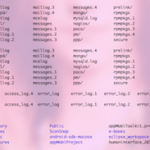こんにちは。
かねしろ@pinkrootです。
今更ながら、いろいろあってMac OS X MarvericsにRuby on Rails環境を作りましたのでその手順や引っかかりどころをメモしておきます。
作った環境は、Railsとunicornとnginxを組み合わせたものです。
前提
- homebrewが入っている
手順
1. homebrewのupdate
まずhomebrewのupdate。
|
1 2 |
sudo brew update |
が、
Error: Failure while executing: git pull -q origin refs/heads/master:refs/remotes/origin/master
的なエラーが。
以下で解決。
|
1 2 3 4 5 |
cd /usr/local git remote add origin git://github.com/mxcl/homebrew.git git fetch origin sudo git reset --hard origin/master |
git resetだけsudo必要だった。
改めて
|
1 2 |
sudo brew update |
2. rbenvの導入とそれを用いたrubyのinstall
|
1 2 3 4 5 6 7 8 9 |
brew install rbenv ruby-build echo 'eval "$(rbenv init -)"' >> ~/.bash_profile echo 'export PATH="$HOME/.rbenv/shims:$PATH"' >> ~/.bash_profile source ~/.bash_profile rbenv install 2.1.2 rbenv rehash rbenv global 2.1.2 |
3. railsのinstall
|
1 2 3 4 5 |
gem install rails gem install bundler rbenv rehash rails -v |
動作確認は
|
1 2 3 4 |
rails new PRJ_NAME cd PRJ_NAME rails server |
でブラウザからlocalhost:3000を確認。
4. unicorn
|
1 2 |
gem install unicorn |
ここから設定
|
1 2 |
vim config/unicorn.rb |
中身は
|
1 2 3 4 5 6 7 8 9 10 11 12 13 14 15 16 17 18 19 20 21 22 23 24 25 26 27 28 29 30 |
# ワーカーの数 worker_processes 2 # ソケット経由で通信する listen File.expand_path('tmp/sockets/unicorn.sock', ENV['RAILS_ROOT']) # ログ stderr_path File.expand_path('log/unicorn.log', ENV['RAILS_ROOT']) stdout_path File.expand_path('log/unicorn.log', ENV['RAILS_ROOT']) # ダウンタイムなくす preload_app true before_fork do |server, worker| defined?(ActiveRecord::Base) and ActiveRecord::Base.connection.disconnect! old_pid = "#{ server.config[:pid] }.oldbin" unless old_pid == server.pid begin # SIGTTOU だと worker_processes が多いときおかしい気がする Process.kill :QUIT, File.read(old_pid).to_i rescue Errno::ENOENT, Errno::ESRCH end end end after_fork do |server, worker| defined?(ActiveRecord::Base) and ActiveRecord::Base.establish_connection end |
(参考)
実行コマンドは
|
1 2 |
unicorn_rails -c config/unicorn.rb |
停止はCtrl+C
nginxが入っていないPCだとunicorn_railsがcommand not foundになるようなので先に下記を参考にnginxの設定も行う。
5. nginx
インストールはhomebrew
|
1 2 |
brew install nginx |
/usr/local/etc/nginx/nginx.conf
に下記のような設定を行う。
|
1 2 3 4 5 6 7 8 9 10 11 12 13 14 15 16 17 18 19 20 21 22 23 24 25 26 27 28 29 30 31 32 33 34 35 36 37 38 39 40 41 42 43 44 45 46 47 48 49 50 51 52 53 54 55 56 57 58 59 60 61 62 63 64 65 66 67 68 69 70 71 72 73 74 75 76 77 78 79 80 81 82 83 84 85 86 87 88 89 90 91 92 93 94 95 96 97 98 99 100 101 102 103 104 105 106 107 108 109 110 111 112 113 114 115 116 117 118 119 120 121 122 123 124 125 126 127 128 129 130 131 132 133 134 135 136 137 138 139 140 141 142 143 144 145 146 147 148 149 150 151 152 153 154 155 156 157 |
# This is example contains the bare mininum to get nginx going with # Unicorn or Rainbows! servers. Generally these configuration settings # are applicable to other HTTP application servers (and not just Ruby # ones), so if you have one working well for proxying another app # server, feel free to continue using it. # # The only setting we feel strongly about is the fail_timeout=0 # directive in the "upstream" block. max_fails=0 also has the same # effect as fail_timeout=0 for current versions of nginx and may be # used in its place. # # Users are strongly encouraged to refer to nginx documentation for more # details and search for other example configs. # you generally only need one nginx worker unless you're serving # large amounts of static files which require blocking disk reads worker_processes 1; # # drop privileges, root is needed on most systems for binding to port 80 # # (or anything < 1024). Capability-based security may be available for # # your system and worth checking out so you won't need to be root to # # start nginx to bind on 80 user nobody nogroup; # for systems with a "nogroup" # user nobody nobody; # for systems with "nobody" as a group instead # Feel free to change all paths to suite your needs here, of course pid /usr/local/var/run/nginx.pid; error_log /usr/local/var/log/nginx/nginx.error.log; events { worker_connections 1024; # increase if you have lots of clients accept_mutex off; # "on" if nginx worker_processes > 1 # use epoll; # enable for Linux 2.6+ # use kqueue; # enable for FreeBSD, OSX } http { # nginx will find this file in the config directory set at nginx build time include mime.types; # fallback in case we can't determine a type default_type application/octet-stream; # click tracking! access_log /usr/local/var/log/nginx/nginx.access.log combined; # you generally want to serve static files with nginx since neither # Unicorn nor Rainbows! is optimized for it at the moment sendfile on; tcp_nopush on; # off may be better for *some* Comet/long-poll stuff tcp_nodelay off; # on may be better for some Comet/long-poll stuff # we haven't checked to see if Rack::Deflate on the app server is # faster or not than doing compression via nginx. It's easier # to configure it all in one place here for static files and also # to disable gzip for clients who don't get gzip/deflate right. # There are other gzip settings that may be needed used to deal with # bad clients out there, see http://wiki.nginx.org/NginxHttpGzipModule gzip on; gzip_http_version 1.0; gzip_proxied any; gzip_min_length 500; gzip_disable "MSIE [1-6]\."; gzip_types text/plain text/xml text/css text/comma-separated-values text/javascript application/x-javascript application/atom+xml; # this can be any application server, not just Unicorn/Rainbows! upstream app_server { # fail_timeout=0 means we always retry an upstream even if it failed # to return a good HTTP response (in case the Unicorn master nukes a # single worker for timing out). # for UNIX domain socket setups: server unix:/path/to/prj_dir/tmp/sockets/unicorn.sock fail_timeout=0; # for TCP setups, point these to your backend servers # server 192.168.0.7:8080 fail_timeout=0; # server 192.168.0.8:8080 fail_timeout=0; # server 192.168.0.9:8080 fail_timeout=0; } server { # enable one of the following if you're on Linux or FreeBSD # listen 80 default deferred; # for Linux # listen 80 default accept_filter=httpready; # for FreeBSD # If you have IPv6, you'll likely want to have two separate listeners. # One on IPv4 only (the default), and another on IPv6 only instead # of a single dual-stack listener. A dual-stack listener will make # for ugly IPv4 addresses in $remote_addr (e.g ":ffff:10.0.0.1" # instead of just "10.0.0.1") and potentially trigger bugs in # some software. # listen [::]:80 ipv6only=on; # deferred or accept_filter recommended client_max_body_size 4G; server_name _; # ~2 seconds is often enough for most folks to parse HTML/CSS and # retrieve needed images/icons/frames, connections are cheap in # nginx so increasing this is generally safe... keepalive_timeout 5; # path for static files root /path/to/prj_dir/public; # Prefer to serve static files directly from nginx to avoid unnecessary # data copies from the application server. # # try_files directive appeared in in nginx 0.7.27 and has stabilized # over time. Older versions of nginx (e.g. 0.6.x) requires # "if (!-f $request_filename)" which was less efficient: # http://bogomips.org/unicorn.git/tree/examples/nginx.conf?id=v3.3.1#n127 try_files $uri/index.html $uri.html $uri @app; location @app { # an HTTP header important enough to have its own Wikipedia entry: # http://en.wikipedia.org/wiki/X-Forwarded-For proxy_set_header X-Forwarded-For $proxy_add_x_forwarded_for; # enable this if you forward HTTPS traffic to unicorn, # this helps Rack set the proper URL scheme for doing redirects: # proxy_set_header X-Forwarded-Proto $scheme; # pass the Host: header from the client right along so redirects # can be set properly within the Rack application proxy_set_header Host $http_host; # we don't want nginx trying to do something clever with # redirects, we set the Host: header above already. proxy_redirect off; # set "proxy_buffering off" *only* for Rainbows! when doing # Comet/long-poll/streaming. It's also safe to set if you're using # only serving fast clients with Unicorn + nginx, but not slow # clients. You normally want nginx to buffer responses to slow # clients, even with Rails 3.1 streaming because otherwise a slow # client can become a bottleneck of Unicorn. # # The Rack application may also set "X-Accel-Buffering (yes|no)" # in the response headers do disable/enable buffering on a # per-response basis. # proxy_buffering off; proxy_pass http://app_server; } # Rails error pages error_page 500 502 503 504 /500.html; location = /500.html { root /path/to/prj_dir/public; } } } |
コマンドは下記の通り。
|
1 2 3 4 |
sudo nginx #起動 sudo nginx -s reload #再起動 sudo nginx -s stop #停止 |
6. 動作確認
|
1 2 |
sudo nginx |
別タブでプロジェクトディレクトリ内から
|
1 2 |
unicorn_rails -c config/unicorn.rb |
ブラウザでhttp://localhostへアクセスし、動作を確認。
403になったのでPRJ_DIRに至るまでの全てのディレクトリの権限設定を見直し、途中に700があったのをchmod 755に変更。
Welcome aboardの画面が表示されればOK。




